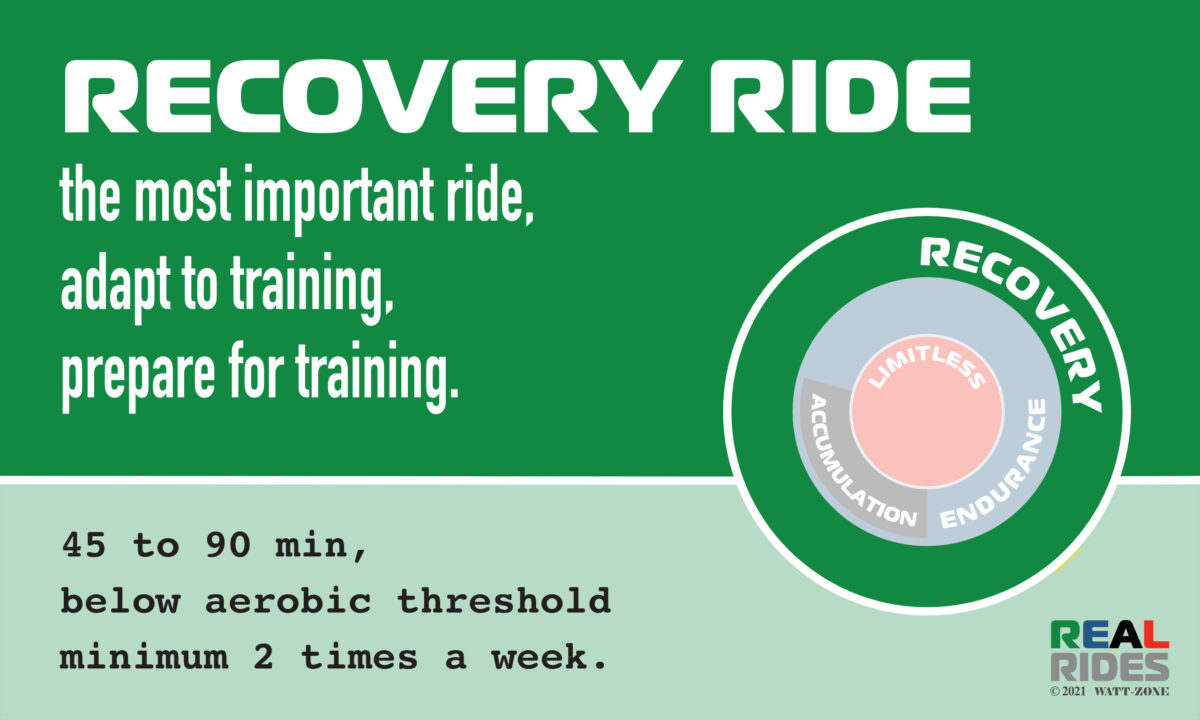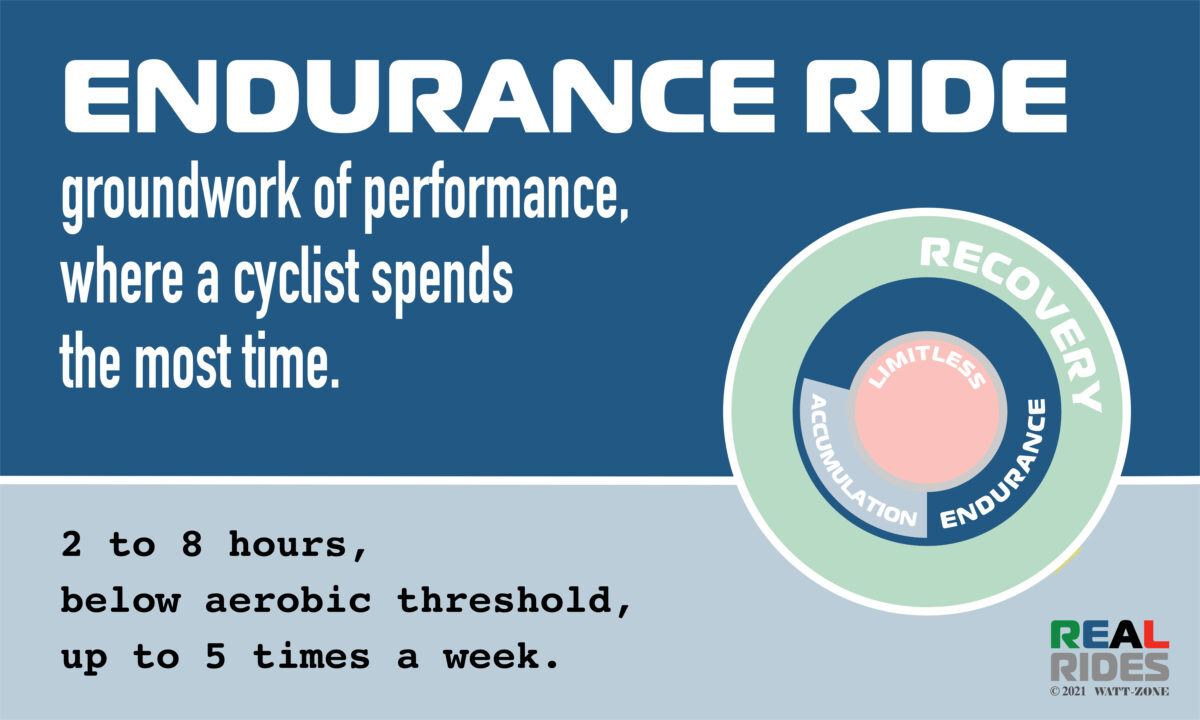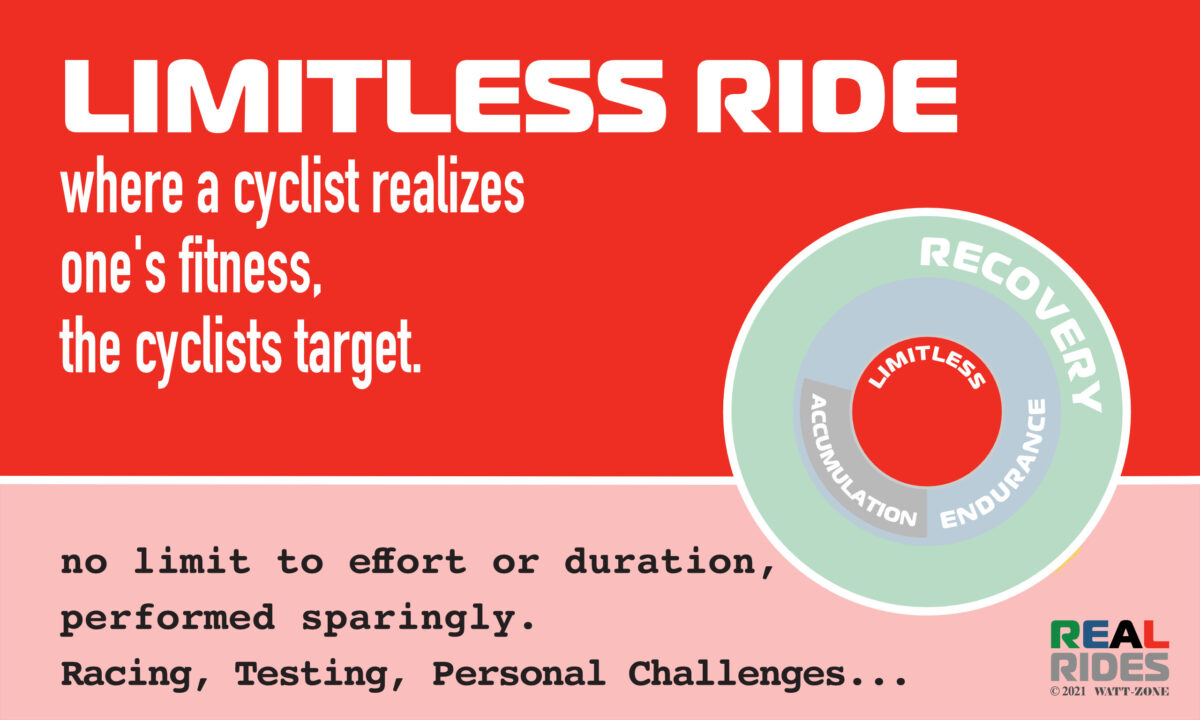An Accumulation Ride is simply where you accumulate time at Effort. Where Effort is described as exercising above the Aerobic-Threshold. An Accumulation ride is where you train for critical efforts and improving key physiological marks. It is where a cyclist shapes their fitness.
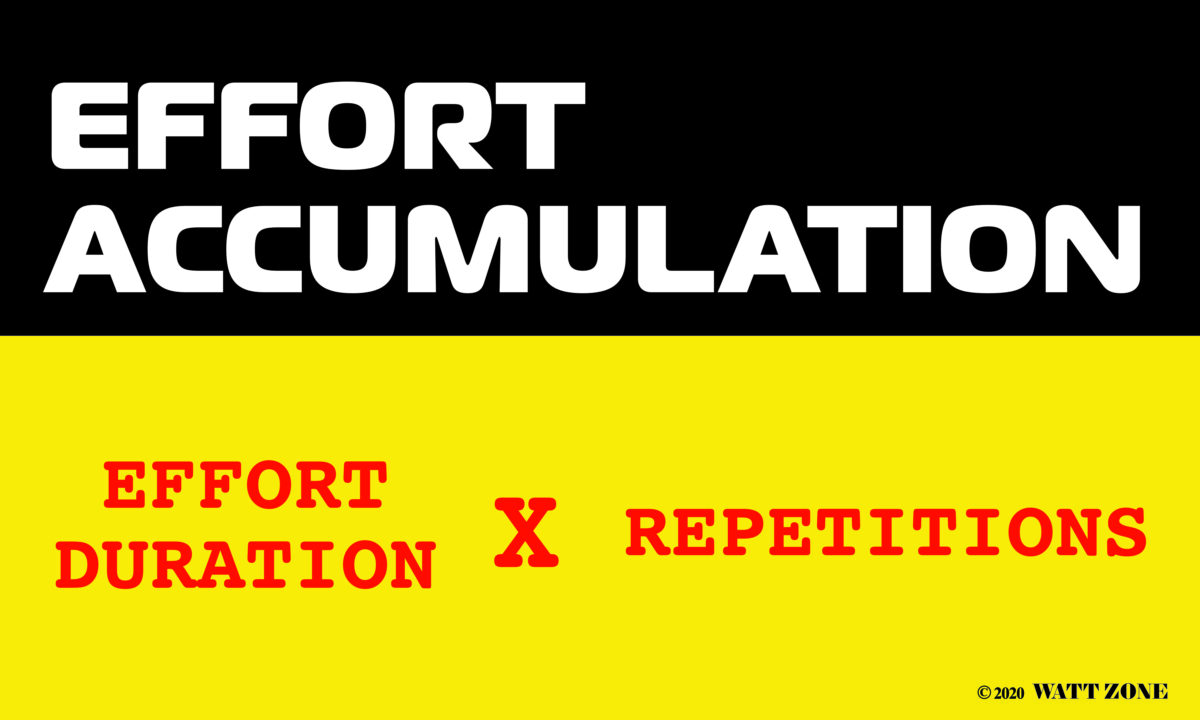
Accumulation is similar to interval training. However, with a focus on accumulated time at Effort. In Accumulation, an Effort Duration {time spent above the Aerobic-Threshold} is repeated. Each repetition accumulates training time above the Aerobic-Threshold.
For example, let’s say you do 5-minute Efforts, repeated 4 times. This yields 20 minutes of Accumulation. One would say they “achieved 20 minutes of Accumulation”. Rather than saying “I did 5-minute intervals”.
Accumulated time at Effort or Accumulation is the key to improved performance. Accumulation is a powerful metric by which riders can plan and monitor their training at Effort.
Just Enough Accumulation
Importantly, with too little Accumulation, no adaptations will occur. Conversely, with too much Accumulation adaptions will be inhibited. In an Accumulation Ride accumulating just enough time at effort is key to a cyclist’s adaptation.
When it comes to achieving just enough Accumulation there are 5 questions everyone asks:
- What duration should my intervals be?
- How many intervals should I do?
- What intensity should I do intervals? / What Zone should I be in?
- What duration should recovery be between efforts?
- The number of high-intensity training sessions per week?
The Accumulation concept provides a framework for answering these important questions.
How long should intervals be? {Effort Duration}
Figuring out the appropriate Effort Duration a cyclist should perform is a big topic. However, the process is relatively simple. Cyclists should take a look at their individual goals and choose what key physiological marks and critical efforts they wish to train for. This will guide the effort duration of their Accumulation Rides and ultimately individually shape their fitness.

Key Physiological Marks and Critical Efforts for cyclists tend to fall into 4 distinct physiological areas: Neuromuscular Power, Anaerobic Capacity, Vo2 Max, and Threshold. They are influenced by training maximally within specific Effort Duration Ranges.
- Micro – up to 30 seconds,
- Short – 30 seconds to 3 minutes,
- Medium – 3 minutes to 8 minutes, and
- Long – 8 minutes to 60 minutes.
The Effort Accumulation Chart shows the Specific Effort Duration Categories in the left column with their corresponding physiological areas on the right.
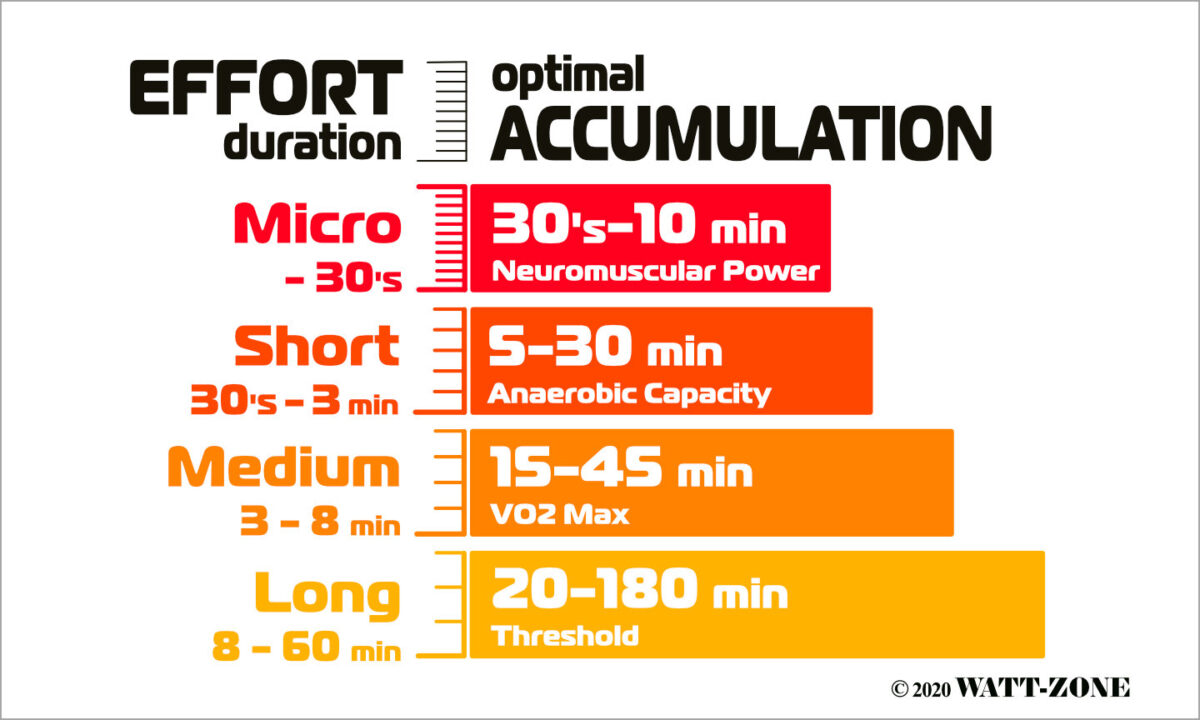
for example…
As an example, let’s say a rider has the goal to complete the local group ride in the front pack. Unfortunately, he has a habit of getting dropped on a long straight. Where the top riders like to go full gas. It works out that our rider has to ride 5–minute all-out, too keep up. We call this a Critical effort.
It makes sense that the rider should practice 5 minute all-out efforts. In the Effort Accumulation model, 5-minute efforts fall into the Medium Efforts Duration category. Correspondingly any efforts within the 3-8 minute range will subtend the goal of improving VO2 max and importantly the rider’s 5-minute Critical Effort.
Effort Duration is a choice a rider must make. Acknowledging that specific Effort Duration’s will affect specific physiological areas will allow a rider to shape their fitness. For example, becoming a better sprinter, rouleur, puncheur, climber… More information can be found in these two posts:
How Many intervals Should I do?

The number of Efforts that should be completed in an Accumulation session is determined by three factors:
- Optimal Accumulation Range
- Rider Profile
- and, Periodisation
Let’s look at these factors using our previous example; our rider has already decided that he needs to complete Medium Effort Durations, 3 to 8 minutes.
Optimal Accumulation
In short, looking at the Effort Accumulation Chart one can see that for each classification of Effort Duration, there is a corresponding Optimal Accumulation Range. For our Rider completing Medium Efforts, there is an Optimal Accumulation Range between 15 and 45 minutes.
Rider Profile and Periodisation
To figure out where In the Optimal Accumulation Range our rider should train simply requires assessing the Rider Profile and current Periodisation.
Looking at the Rider’s Profile; he’s pretty new to cycling and hasn’t performed a lot of Accumulation training in the past. But he has been riding consistently for a year. So he decides that perhaps the best place to start is 20 minutes of Accumulation. A point lower in the Optimal Accumulation Range.
To get this he could do:
- 4 minute repeats x 5 repetitions
- 5 minute repeats x 4 repetitions
All goes well in his Accumulation Ride and he Accumulates 20 minutes time at effort. He realizes that to improve he should probably increase his Accumulation the following week and decides to aim for 24 minutes. This is just basic Periodisation utilizing progressive overload. To do this with Medium Efforts he could do:
- 8 minute repeats x 3 repetitions
- 4 minute repeats x 6 repetitions
The choice is his.
What we can clearly see is that after a rider has chosen an Effort Duration, Optimal Accumulation is then pinpointed by analyzing the Rider’s Profile and current Periodisation. Then simply, Optimal Accumulation divided by Effort Duration, determines the number of Efforts.
The number of Repetitions is not important. Optimal Accumulation is most important.
How hard should I do Intervals?
In the Effort Accumulation model, there is one simple overriding concept that guides intensity. Efforts should be performed at a maximum repeatable intensity given the desired accumulation. In other words, cyclists should strive to complete all efforts within a session at the same intensity. Along with the caveat that they should not feel able to perform an extra Effort at that intensity.
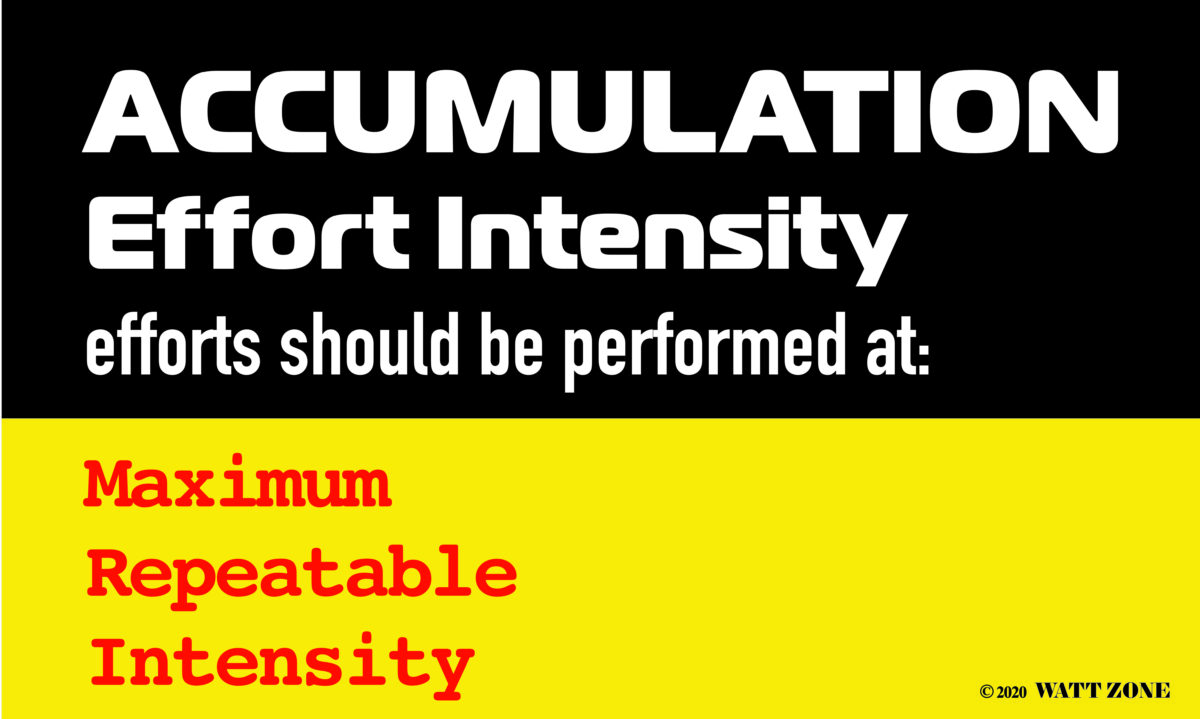
Have you ever gone out too hard on the first few intervals of a session and ended up not being able to complete all the planned repeats? In this situation, the planned accumulation is not achieved, and most likely the intensity too high so that potential adaptions are inhibited.
On the other hand, have you ever gone out too easy, and started adding repeats to a planned session, or increasing the intensity of each interval. Here, Productive Accumulation is not achieved. With the overall session not being intense enough to facilitate adaptions.
Upon reaching the Desired Accumulation. You should subsequently feel, that you have reached your limit. And can do no more. Done just enough.
Feel
Pinpointing the Maximum Repeatable Intensity for any given session relies heavily on feel. Without a doubt, feel is an intangible skill that athletes can develop drawing upon heart rate data, power data, and perceived exertion from training, testing, and performance of intervals. This is a skill that has somewhat been lost in today’s data and technology-driven sport, but honing one’s “feel” is perhaps one of the most beneficial things a cyclist can do.
How much Recovery between Efforts?
Above all, athletes must remember the goal of their Accumulation Ride. To accumulate time at effort {above the aerobic threshold} at a maximum repeatable intensity. In addition, recovery time needs to be sufficient to allow repeatability. For most efforts it is considered, that between 2 and 4 minutes should be sufficient recovery.
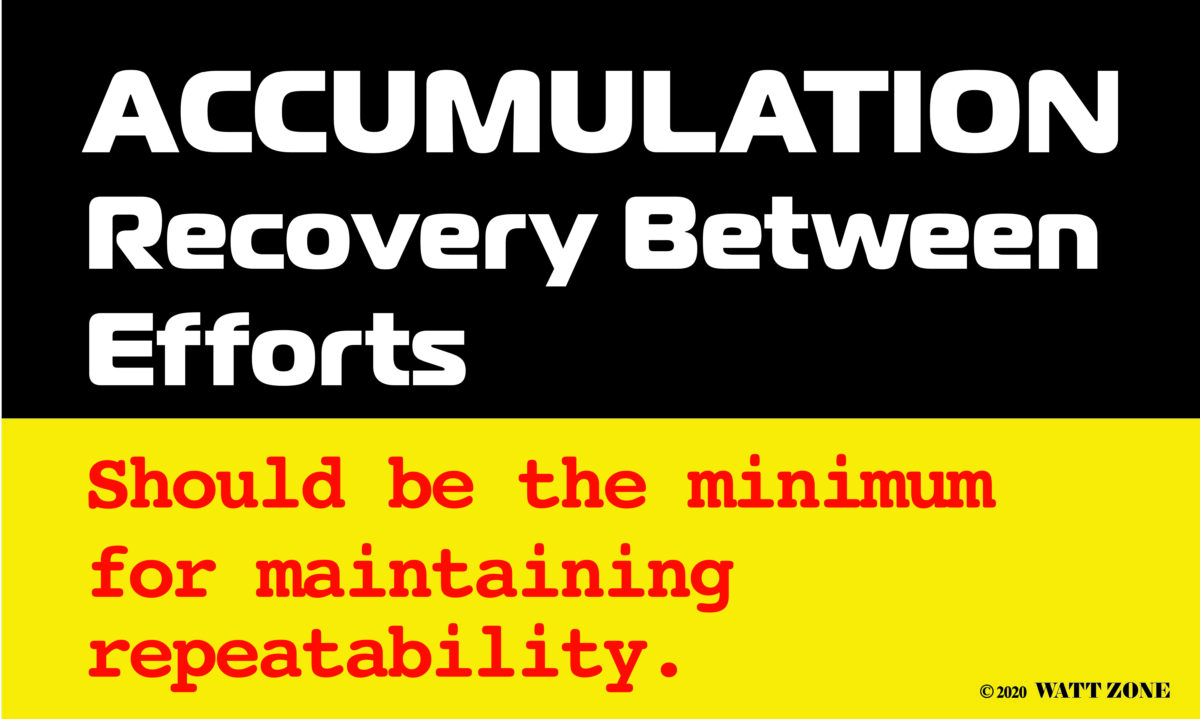
In addition keeping the recovery time to a minimum that will still support repeatability is a good idea. This avoids excessively long sessions and promotes the ability to recover faster, something that is very beneficial when raing.
How many Accumulation Rides per week?
How many accumulation rides should I do a week, the answer is deduced from the following rule: Accumulation Rides should be followed up the next day with a Recovery Ride.
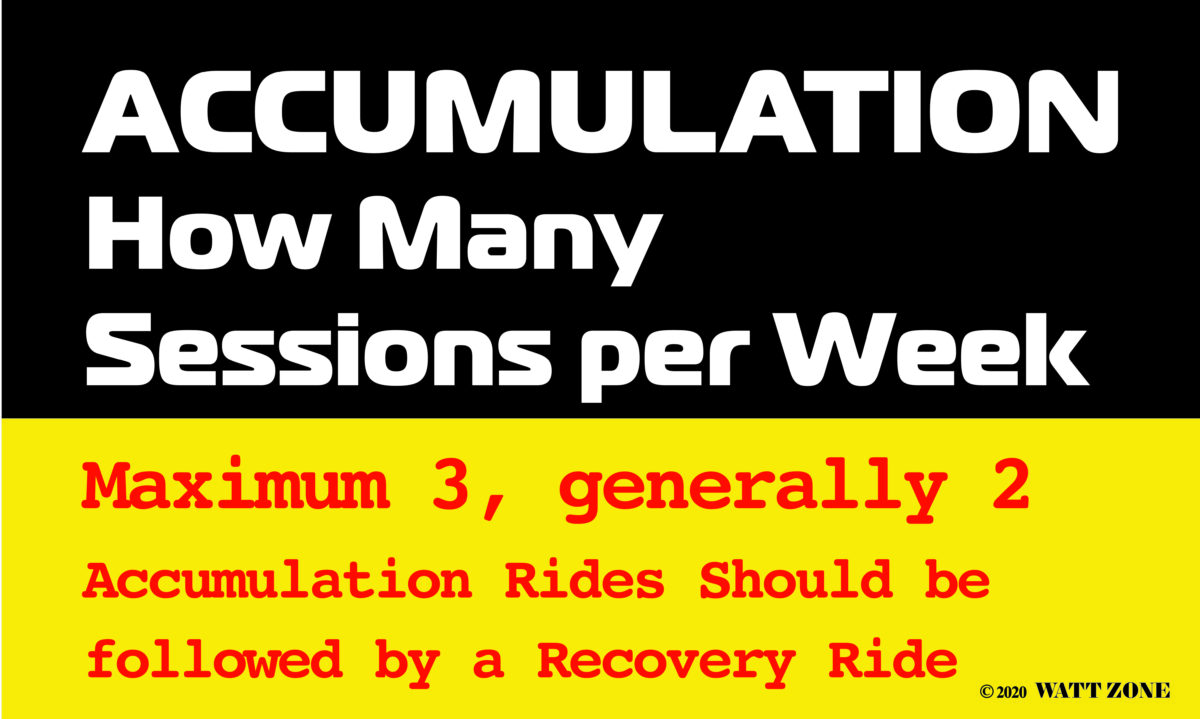
Without a doubt, the Accumulation Ride, to accumulate time at Effort, should be the hardest training sessions of the week. An athlete should feel empty at their completion. It just makes sense to follow up with a Recovery Ride.
Given a training plan structured around a 7 day week. And the knowledge that every Accumulation Ride should be followed by a Recovery ride. Consequently, this really only leaves space for 3 Accumulation sessions maximum, as every session should be followed by a Recovery session. But we really only recommend 3 Accumulation Ride’s per week during specific preparation phases.
Two sessions per week is optimal for the majority of one’s training. Especially given that we also recommend that at least one Endurance Ride should be included in a normal training week. It is also possible to include an accumulation session within an Endurance ride, but only when doing so has a clear purpose.
Accumulation Addendum
Periodisation
One of the benefits of having Accumulation as a primary goal is its usefulness as a metric for planning one’s training. It’s a metric that is easy to measure and manipulate. In the same way, one manipulates the duration of a long ride with progressive overload and recovery, accumulation can also be periodized. For instance, let’s say in a six-week training block at a given “effort-duration”, a cyclist may start at 20 minutes Accumulation for a particular session, and progress to 40 minutes by the end of the block.
But What Zone?
The principle that “efforts should be performed at a maximum repeatable intensity given the desired accumulation” removes the need for assigning or even defining traditional training zones. When performing an Accumulation Ride, Effort-Duration, and desired Accumulation determine the intensity and consequently energy systems being trained.
What about Efforts that are not at maximal repeatable intensity.
On the other hand, it is common for riders to complete Efforts at a level below maximal repeatable intensity. But still above the Aerobic Threshold. The only reason to do such training is for very specific reasons; to work on strength, efficiency, or for maintenance. Such training is still fatiguing, and difficult to periodize.
It is the type of training that many athletes fall into completing far too often. Moreover, riders should treat sessions like this as Accumulation rides. Consequently, they should be followed by a Recovery Ride.
Summary
When performing an Accumulation Ride to accumulate time at Effort it is important to:
- realize an Effort represents a duration of time spent above the Aerobic-Threshold, that is usually is repeated.
- choose an Effort Duration in accordance with training for critical efforts and improving key physiological marks.
- be guided by optimal levels of Accumulation (see Optimal Accumulation).
- Acknowledge one’s Rider Profile, and current Periodisation to pinpoint a Target Accumulation.
- performed at a maximum repeatable intensity given the desired accumulation.
- have the minimum recovery time between efforts to maintain repeatability.
- complete a maximum of 3 sessions per week (more commonly 2).
- follow up with a recovery ride.
- Attaining just enough accumulation is key to a cyclist’s adaptation.


